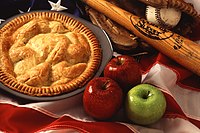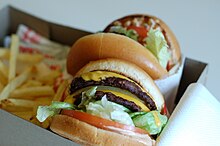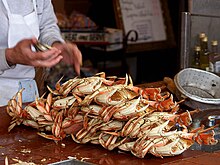Cuisine of California

| Part of a series on |
| American cuisine |
|---|
 |
The cuisine of California reflects the diverse culture of California and is influenced largely by Hispanic American roots (Mexican, Latin American, Spanish), alongside Eastern Asian and Oceanian influences (Japanese, Chinese, Filipino, Vietnamese, Thai, Hawaii) and Western European influences (Italian, French, Portuguese), as well as the food trends and traditions of larger American cuisine.
The main trends were influenced by a combination of Mediterranean climate, geography and geology of the region's proximity to the ocean, its movie roots in Hollywood, its technology roots in Silicon Valley and the Napa wine country, as well as its major produce production. Even California being part of Mexico influenced the state's food.
Local ingredients
A varied range of micro-climates, dominated by a mild Mediterranean climate, and health-conscious diets and lifestyles in California, promote the production, use and consumption of fresh fruits, vegetables and meats, many of them organic.
In Northern California, with wine country nearby, French, Italian, and Mediterranean inspired food is prominent, as well as Asian-inspired fare. Many of the restaurants, cafes, bistros, and grills use ingredients sourced from local growers and farmers' markets.[2][3] A unique sourdough-style bread has its origins in San Francisco.[4]
The California coast, especially the North Coast and Central Coast regions, is a source of seafood, which is a staple in the California diet.
California produces almost all of the country's almonds, apricots, dates, figs, kiwi fruit, nectarines, olives, pistachios, prunes, and walnuts. It leads in the production of avocados, grapes, lemons, melons, peaches, plums, and strawberries.
This agricultural diversity of California's Central Valley provides fresh produce in the state. On less than 1 percent of the total farmland in the US, the Central Valley produces 8 percent of the nation's agricultural output by value.[5]
Sunset, a magazine of the West published in California, has featured recipes that have influenced the cuisine of California, including the promotion of outdoor eating.
Sandwiches, burgers, and fast food

Southern California's car culture and the population's reliance on automobiles for transportation throughout California's vast cities, has widely contributed to the popularity of the classic drive-in and modern drive-through restaurants. Restaurant chains such as McDonald's,[6] Jack in the Box,[7] In-N-Out Burger,[8] Carl's Jr.,[9] Wienerschnitzel,[10] Del Taco,[11] Taco Bell,[12] Panda Express,[13] Original Tommy's,[14] Fatburger,[15] and Big Boy[16] were all established in Southern California.
Regional fast-food menus differ, generally depending on the ethnic composition of an area. In Southern California, smaller chains like The Hat feature hamburgers, Mexican food, chili fries, and pastrami.
While gastropubs are not unique to California, the concept of the gourmet burger is very popular.
Latino and Hispanic influences
Because of California's mostly colonial European Spanish roots, Mexican territorial history, and its original population consisting of Meso-Americans, Spanish colonizers and Mexican ranchers, Mexican and Spanish-origin cuisine is very influential and popular in California, particularly Southern California.[17]
Commercial taquería-style Mexican fast food, consisting of offerings such as burritos, refried beans, tortas, tacos, nachos, and quesadillas, is widely popular. Taquerías can be found throughout California.
Traditional Mexican food, while not as common as commercial food, is still widely prepared and abundant in the ethnic Mexican American border communities of San Diego, the Los Angeles metropolitan area, the San Francisco Bay Area, and in Mexican-American enclaves throughout California. Examples of these foods include tamales, tortillas, tostadas, mole, menudo, pozole, sopes, chile relleno and enchiladas.
In addition to Mexican food, California restaurants serve up nearly every variation of Central American food there is. For example, pupuserías are common in areas with a large population of Salvadorans (pupusas are stuffed tortillas from El Salvador).[18]
More recently, "Fresh-Mex" or "Baja-style" Mexican food, which places an emphasis on fresh ingredients and sometimes seafood, inspired by Baja California fare, is highly popular. El Pollo Loco, a fast-food chain that originated in Northern Mexico, is a common sight. Rubio's Fresh Mexican Grill, Baja Fresh, Wahoo's Fish Taco, Chronic Tacos, Chipotle, Qdoba and La Salsa are examples of the Baja-style Mexican-American food trend.
Shellfish and seafood

In Northern California and the Central Coastal region, Dungeness crab is abundant. Sardines and salmon were formerly major industries, before declines in fish stocks.[19][20] Cioppino (a fish stew) is a classic example of Northern Californian cuisine.
Asian and Oceanian influences
As one of the U.S. states nearest Asia and Oceania, and with long-standing Asian American and Oceanian American populations, the state tends to adopt foods from those national styles.[21] The American style of sushi possibly began in California; the term "California roll" is used to describe sushi with avocado as a primary ingredient. Recently, East Asian confectionery such as mochi ice cream and boba have gained popularity throughout California and the United States, with many establishments that produce them beginning in California.
Fusion cuisine
Fusion cuisine is quite popular in California.[22] The emphasis of California cuisine is on the use of fresh, local ingredients which are often acquired daily at farmers markets. Menus are changed to accommodate the availability of ingredients in season. Some restaurants create a new menu daily.
California chef Wolfgang Puck is known as one of the pioneers of fusion cuisine, popularizing such dishes as Chinese chicken salad at the restaurant Ma Maison in Los Angeles. His restaurant Chinois[23] in Santa Monica was named after the term attributed to Richard Wing, who in the 1960s combined French and Chinese cooking at the former Imperial Dynasty restaurant in Hanford, California.[24]
California-style pizza

California-style pizza focuses on non-traditional pizza ingredients, such as fresh produce and barbecued meats. First popularized by Wolfgang Puck's Spago restaurants, it was later brought to the masses by restaurants such as California Pizza Kitchen.[25]
Barbecue
Barbecue has been a part of California cuisine since Mexicans cooked beef in pit barbecues on ranches since the 1840s. Santa Maria, California, is famous for the tri-tip, a special kind of beef cut that can be grilled, baked, braised, or roasted.[26]
California's barbecue style is also influenced by the styles of Arizona, New Mexico, Texas, and Oklahoma, brought by Dust Bowl migrants. Chicken, beef ribs, sausages, and steaks are also grilled or smoked in a barbecue pit.
The barbecue sauce used in this state is tomato-based,[27] as with all other western states. Santa Maria barbecue, however, uses no sauce, relying instead on the flavor of the tri-tip and the slow live-oak fire over which it is cooked.
Pork baby back ribs are popular for barbecue in the Western region in comparison to the popular use of spare ribs in the United States.
Gourmet food products
Many gourmet food products and companies had their start in California, including Peet's Coffee & Tea.[28]
References
- ^ "Tacos Sinaloa – Berkeley - a MICHELIN Guide Restaurant". MICHELIN Guide. Retrieved 2021-03-27.
- ^ Vileisis, Ann (2008). Kitchen Literacy: How We Lost Knowledge of Where Food Comes from and Why We Need to Get It Back. Island Press. ISBN 9781597263733.
Waters forged relationships between farmers and other chefs throughout northern California to create a regional supply network.
- ^ Weir, Joanne (2008-08-01). Wine Country Cooking. Ten Speed Press. p. 5. ISBN 9781580089388.
It's taking an extra moment to really savor ... a lunch based on luscious fresh vegetables from your own garden or bought at your local farmer's market.
- ^ Saekel, Karola (2005-09-07). "CULINARY PIONEERS / From Acme bread to Zuni Cafe, the Bay Area has shaped how America eats". SFGATE. Retrieved 2021-07-20.
- ^ "California's Central Valley". USGS California Water Science Center. United States Geological Survey. 2017-03-20. Retrieved 2017-06-13.
Using fewer than 1% of U.S. farmland, the Central Valley supplies 8% of U.S. agricultural output (by value) and produces 1/4 of the Nation's food, including 40% of the Nation's fruits, nuts, and other table foods.
- ^ "TODAY IN HISTORY: Original McDonald's opened in San Bernardino in 1940". The Press-Enterprise. 2016-05-15. Retrieved 2017-06-13.
- ^ "Our Company". Jack in the Box. Archived from the original on 2017-11-19. Retrieved 2017-06-13.
In 1951, a businessman named Robert O. Peterson opened the first Jack in the Box restaurant in San Diego
- ^ "Replica of the First In-N-Out Burger". RoadsideAmerica.com. Retrieved 2017-06-13.
In-N-Out Burger was started in Baldwin Park [California] in 1948 by Harry and Esther Snyder.
- ^ "CKE Restaurants - History". CKE Restaurants. Archived from the original on 2017-05-18. Retrieved 2017-06-13.
In 1956, Carl expanded his business by opening the first two Carl's Jr. restaurants in Anaheim and nearby Brea.
- ^ "1938-2013: John Galardi, founder of Wienerschnitzel, opened first stand in Wilmington". Daily Breeze. Associated Press. 2013-04-15. Retrieved 2017-06-13.
John Galardi, who opened his first Wienerschnitzel hot dog stand in Wilmington [California] in 1961
- ^ "Del Taco - History". Del Taco. Retrieved 2017-06-13.
Ed Hackbarth and David Jameson opened the first Del Taco in Yermo, CA in 1964.
- ^ Luna, Nancy (2015-11-18). "Saved from the wrecking ball: Taco Bell to relocate original 1962 Downey food stand to Irvine". Orange County Register. Retrieved 2017-06-13.
Glen Bell opened the first Taco Bell March 21, 1962 at 7126 Firestone Blvd. in Downey [California].
- ^ Greenfeld, Karl Taro (18 November 2010). "General Tso, Meet Steven Covey". Bloomberg Businessweek. Bloomberg, L.P. Retrieved 2017-06-13.
In 1983 he opened the first Panda Express in the Glendale Galleria mall.
- ^ Kallas, Anne (2011-12-15). "Original Tommy's opens in Ventura". Ventura County Star. Retrieved 2017-06-14.
Original Tommy's was founded in 1946 by Tom Koulax, and the first stand opened at Beverly and Rampart boulevards in Los Angeles.
- ^ "Founder of Fatburger has died". KABC-TV. 2008-02-02. Retrieved 2017-06-14.
Lovie Yancey, who started Fatburger in South Los Angeles in 1947
- ^ Slavin, Barbara (1978-08-10). "Drive-ins and carhops are things of the past". The Day. New London, Connecticut. New York Times News Service. p. 5. Retrieved 2017-06-13.
the California-based chain Bob's Big Boy—a chain whose founder, the late Bob Wian, is generally credited with opening the first drive-in restaurant on Aug. 6, 1936, in Glendale
- ^ Oden, Barrett (2016-11-21). "Fry Bread, Casinos and Mexican Cuisine: Native American Food in California". LA Weekly (Interview). Interviewed by Katherine Spiers. Retrieved 2017-06-13.
- ^ Villanueva, Ivan (2014-08-12). "A View From Within: Salvadorans in America". Retrieved 2017-06-13.
Consequently, there are more Salvadorans in Los Angeles than any other place in the world outside of El Salvador
- ^ Tucker, Abigail (October 2008). "On California's Coast, Farewell to the King Salmon". Smithsonian.
- ^ Kinney, Aaron (April 15, 2015). "California salmon outlook is good for 2015, ominous in the long run". Santa Cruz Sentinel.
- ^ Wang, Oliver (2015-11-11). "We Are What We Eat: Asian Americans and Food". PBS. Retrieved 2017-06-13.
- ^ Bowers, Sharon. "California Fusion". Archived from the original on 2001-04-07.
- ^ "Wolfgang Puck | Chinois, Santa Monica". Wolfgang Puck. Retrieved 2021-03-27.
- ^ Khokha, Sasha (2005-07-15). "In Rural California, an Imperial Dynasty Ends". National Public Radio.
- ^ Lauriston, Robert (2007-09-26). "Pizza Smackdown: SoCal chain goes head to head with hometown favorite". SF Weekly. Archived from the original on 2007-12-25. Retrieved 2017-06-13.
- ^ Morris, Jim (July–August 2007). "Legendary barbecue". California Country Magazine. Sacramento, California: California Farm Bureau Federation. Retrieved 2017-06-13.
- ^ Westerman, Kim (2015-08-14). "Bay Area Bites Guide to the 10 Best American-Style Barbecue Joints in the East Bay". KQED. Retrieved 2017-06-13.
The homemade sauces, spicy and mild, are mostly tomato-based.
- ^ Marshall, Carolyn (2007-09-03). "Alfred H. Peet, 87, Dies; Leader of a Coffee Revolution". The New York Times.
Mr. Peet, often called the 'grandfather of specialty coffee,' started his business in Berkeley, Calif., in 1966
External links
 Cuisine of California at the Wikibooks Cookbook subproject
Cuisine of California at the Wikibooks Cookbook subproject Media related to Cuisine of California at Wikimedia Commons
Media related to Cuisine of California at Wikimedia Commons
